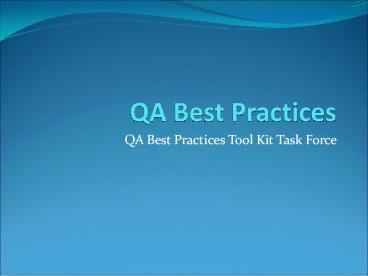QA Best Practices - PowerPoint PPT Presentation
1 / 28
Title:
QA Best Practices
Description:
QA Best Practices Tool Kit Task Force The Back Story QA Summit The Healthcare Documentation Quality Assessment and Management Best Practices Tool Kit Locating QA Best ... – PowerPoint PPT presentation
Number of Views:1023
Avg rating:3.0/5.0
Title: QA Best Practices
1
QA Best Practices
- QA Best Practices Tool Kit Task Force
2
The Back Story
- QA Summit
3
Locating QA Best Practices Info
4
Healthcare Documentation Quality Assessment and
Management Best Practices July 2010
5
Dissecting the Document
- Principles of Quality
- Factors Affecting Quality
- Personnel
- Assessment Policies and Procedures
- Sampling Guidelines
- Error Categories, Definitions, Scoring
- Continuous Quality Improvement
- Recommendations
6
PDCA (Shewhart Cycle or Deming Circle)
- PLAN
- DO
- CHECK
- ACT
7
Principles of Quality
- Verifiability
- Definability
- Measurability
- Consistency
- Integrity
8
Quality Assurance Guidelines
- Accurate and complete medical records
- Timely and accessible distribution
- Statistically valid sampling
- Auditing applied to all documents, however
created - Consistent unbiased review
- Error values consistent with definitions herein
- Consistent communication regarding errors
- Availability of reference materials and account
specifications
9
Comprehensive Quality Assurance Programs
- Proactive
- Educational
- Realistic, scalable, and financially feasible
- Simple and easy to implement
- Secure and confidential
- Inclusive of all aspects of the author-to-text
process - Reportable for tracking and trending purposes
- Timely
10
Factors Affecting Quality
- The Author
- Experience
- Equipment
- Patient Demographics
- Account Specifications
- Resources
11
BLANKS ___
- VALID
- INVALID
12
Personnel
- The Quality Players
- - Medical Transcriptionists
- - QA Editors / Supervisors / Managers
- - Support Staff / IT
- - Healthcare Providers
- - Administration / HR
- - Trainers / Instructors
- - Educational Institutions
13
QA Guidelines
- Policies and Procedures
- - Concurrent Review
- - Retrospective Review
- - Flagged Documents
- - Feedback
- - Author Assessment
14
Sampling Guidelines
- Statistically Valid Sampling
- - Random
- - Sample Size
- 1 per month recommended
- 95 confidence level
- 0.851 margin of error
15
Error Categories
- Critical Errors
- Affect patient safety, care, or treatment
- Noncritical Errors
- Have an impact on document integrity
- Feedback Errors / Educational Opportunities
- Do not change meaning or affect patient care
16
Critical Errors
- Terminology Misuse
- Omissions/Insertions
- Incorrect Patient Demographics or
- Author Identification
17
Noncritical Errors
- Misspelling
- Incorrect Verbiage
- Failure to Flag
- Protocol Failure
- Formatting/Account Specifications
18
Feedback Errors / Educational Opportunities
- Grammar
- Punctuation
- Capitalization
- Plurals
- Run-on/fragment sentences
- Abbreviations
- Slang
- Inconsequential typos and omissions
- Incorrect word forms
19
Scoring
- Error Value from 100 Method
- - If same error repeated, count only once
- - Score of 98 is considered passing
- - Deduct 3 points for a critical error
- - Deduct 1 point for a noncritical error
- - Deduce 0 points for an instructional error
- Any report with a critical error should fail.
- Pass/Fail vs Scored Audit
20
Continuous Quality Improvement Process
21
Quality Improvement Strategies
- Set quality assessment intervals
- Monthly, quarterly, semiannually, or annually
- Customize to individual
- Address system wide problems
- Areas to be addressed
- Technical systems
- Author issues (See also Dictation Best Practices
Tool Kit) - Account specifications
- MT concerns
22
Steps to Implementation
- Importance of Adopting QA Best Practices
- Getting Started
- Making the Transition
- Transition Tools
23
Importance of Adoption
- Changing world
- EHR
- Cost reduction
- Need for new best practices
- Work for patient safety, focusing on critical
errors impacting patient care - What the new QA Best Practices do
- Consistent, verifiable standards for all modes
of document creation.
24
Getting Started
- Evaluate current system
- Work to overcome barriers
- Encourage a cultural shift
- Explain scoring methodology and rationale
25
Transition Techniques and Tools
- Why the Changes Handout
- Adoption Guide
- Checklists
- Scoring Spreadsheet
- Scoring Spreadsheet Video
26
Recommendations
- Apply principles of quality
- Assess factors affecting quality
- Establish clear policies and procedures
- Develop a feedback mechanism
- Provide training and mentoring
- Follow a quality assessment schedule
- Compile, track, and analyze QA data
- Remember PDCA!
27
QUESTIONS?
28
THANK YOU!































